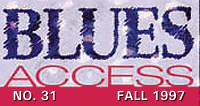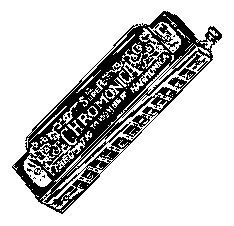

 | ||
| The Doctor is In! |

Stranger things have happened. In fact, they happen all of the time around the International House of Harpo, Mission Control for the life and times of the man I like to call me (collect on alternate Sundays, and never frequently enough). Never even a postcard. Why I could be dead, but do they care? You give them the best years of your life and ... whoops, channeling reruns of Rhoda again. Enough, already. Anyhow, redecoration at the crib included installation of an amoeba-shaped coffee table, which surreptitiously threw out a fleshy foot and ingested one of this month's letters. The gist of the note, another plaintive cry for help (still with no dollar enclosed, in spite of repeated hints), was on the topic of beginning chromatic harp playing.
Let's get one thing straight here, Bucko. Do you want to play pseudo-third position, a la Rod Piazza and Little Walter, the "screw the button, full-speed ahead" approach, where you play the chromatic just as it's laid out, without engaging the other register of reeds with the little slide thingie? If that's the case, then it's relatively easy to learn how, especially if you've noodled around with third position on a diatonic, typical 10-holer harp.
The "good" notes, the ones that fit best for playing in third position, are the four through seven holes, the ones that make up an eight-note scale if you play them in sequence. They also yield a major chord on blow and a minor sixth chord on draw. So, judicious use of this position yields possibilities for both major and minor playing. The above four-note pattern is repeated up and down the length of all chromatic harmonicas -- so there you are. The only exception to this is the "Koch" Harmonica put out by Hohner, which is set up like a pair of diatonic harps in love, a C and a C# joined forever, connected by a button. The usual configuration, Kochs aside, is three or more repetitions of this four-note scale pattern up and down the chro. It's the same pattern of notes as the sweet spot for third position, So, if you know one, you know the whole thing.
However ... learning chromatic in the way it was originally intended -- as an instrument usable in all keys with a full chromatic (there's that word again) scale available -- involves different skills than playing diatonic. You can't just pick it up and honk out a passable tune and chords to accompany a I-IV-V progression, as many of us did with our first Marine Bands. The notes just aren't laid out in a pattern that allows that, with the exception of playing in third position, which I just heard a lot of talk about a minute ago. You need to learn the layout of the notes on the harmonica, both in the eight-tone scale and the chromatic scale. Then you have to practice scales in the various keys because you only have one harp to fit all tunes. Finally, you need to learn the notes in various chords so that you can play in other progressions besides the usual three-chord pattern we all know and love on 10-holers. It wouldn't hurt to take a course or two in music theory or read some books on the subject. As if that isn't all, you might be well-advised to learn how to read music, as long as you're taking on this challenge of new skills. I'd recommend that you get one or two of the excellent instruction books on the subject and put in the time mastering the intellectual side of playing at the same time you are mastering the motor skills you need.
What skills, you ask? You'll regret asking. Chromatics are similar to diatonics in that they both have holes and they are manufactured by the same companies. That's it. Other than that, learning chromatic is as difficult as learning any other new instrument, like a saxophone or a VCR. You will not automatically have a good tone or even sound the notes consistently cleanly, as it's a very unforgiving little sucker. You need more breath control than ever before, as chromatics can be overblown (in that the reeds get too much air and shut down or sound like a fax machine) easily. So, figure on practicing 15 to 30 minutes, once or twice a day, very consistently, until you pass the "Jeez, I suck" stage without becoming totally frustrated and making the thing into a chia harp.
A word on student-level instruments. Don't. Imposing a hard-to-play instrument that wouldn't qualify for use by a bos'n on anyone in the learning stages of playing anything, may guarantee failure and chia status. Drop the dough on a good, make that a great harp. A treble-tuned (one octave lower) 270 chromatic from Hohner is a sweet thing to use and is professional quality. A cheapo alternative intended for students to use while learning the chromatic layout is the Hohner 365 straight-tuned harp, the same frame used for 365 bass harps but tuned like a chro. It sounds wicked loud and has a sharp tone, sort of halfway between a diatonic and a chromatic.
If you go to all of this trouble, the result will be that you can, at least theoretically, play anything. Not a bad goal, eh? If this doesn't cover the question that our friend asked in his disappearing letter, please follow up and I'll keep it off my coffee table.
The following is reprinted as a public service, and without editorial comment. Words simply fail me.
Dear Harpo,
Just like many people in the entertainment industry take a stage name (McKinley Morganfield -- Muddy Waters, Ellis McDaniels -- Bo Diddley, etc.), or a nom de plume (nom de harp in your case), the writer of the last letter you published used an assumed name. Or, to put it another way: You've been had.
Doug "Lepetomaine" wrote saying that he needed a new way of playing the harp, and you provided him with a long, involved, serious, dignified (if anything you write could ever be thought of as being dignified, and I mean that in a good way) answer. However, a perusal of the enclosed photocopies from Felton and Fowler's More Best, Worst and Most Unusual (Information House Books, 1976) will show that he was being anything but serious in his letter. One might even think that his use of the word "breakthrough" was related to the phrase "breaking wind." '
Yes, his alleged last name has an extra "i" in it, but it is readily apparent that he was just having a little fun. Now, if he has used that name in asking for help in playing guitar, drums, or any instrument other than a "wind" instrument, you could assume that could be his real name. But when he is asking for help in finding a new way of blowing, the only conclusion that one can come to is that he pulled a fast one and got away with it.
Granted, this is not on a par with hoaxes such as psychic surgery and the Piltdown Man, but it was nonetheless a good use of an obscure historical persona, so don't feel bad. Keep on blowin'.
Rod Gregson
Moorpark, California
The quote in question: "French audiences were captivated by an even more outrageous act. In The City of God Book XIV, St. Augustine assures us:'There are individuals who can make musical notes issue from the rear of their anatomy, so that you would think they were singing.' Vaudevillian Joseph Pujol (1851-1945), otherwise known as "Le Petomane," was one soul blessed with this Rabelaisian talent, and he made it pay off handsomely. From 1892 to 1914, Pujol was a headliner at the famous Moulin Rouge, where he drew gates as high as 20,000 francs, while the Divine Sarah Bernhardt only managed to pull 8,000 francs. With his well-tempered derriere, he performed a series of phenomenal stunts -- rendering flatulent impressions of famous opera singers, playing the ocarina through a rubber tube and blowing out a candle from a distance of one foot. For an encore, Le Petomane would solemnly ask his audience to stand while he farted the 'Marseillaise.' "
Send a letter to Dr. Harpo and receive a small nugget of truth wrapped in a carpet of irrelevancy. And you only have yourself to blame.
 |
 |